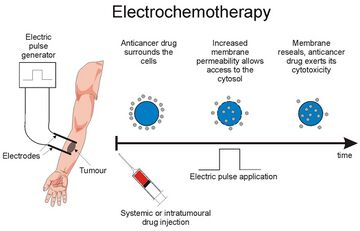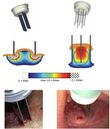Medicine:Electrochemotherapy
| Electrochemotherapy | |
|---|---|
| Specialty | oncology |
Electrochemotherapy (ECT[1]) is a type of chemotherapy that allows delivery of non-permeant drugs to the cell interior. It is based on the local application of short and intense electric pulses that transiently permeabilize the cell membrane, thus allowing transport of molecules otherwise not permitted by the membrane.[2][3] Applications for treatment of cutaneous and subcutaneous tumors have reached clinical use by utilizing drugs such as bleomycin or cisplatin).[4][5][6][7][8][9][10][11][12][13] Electrochemotherapy with bleomycin was used to treat a patient for the first time in 1991 at the Institute Gustave Roussy in France,[14] while electrochemotherapy with cisplatin was used to treat for the first time in 1995 at the Institute of Oncology, Ljubljana, Slovenia.[15] Since then, more than 4000 patients were treated with electrochemotherapy all over the world (Argentina, Australia, Austria, Belgium, Bulgaria, Denmark, France, Germany, Greece, Hungary, Ireland, Italy, Japan, Mexico, Nicaragua, Poland, Portugal, Slovenia, Spain, Sweden, UK, USA). Recently, new electrochemotherapy modalities have been developed for treatment of internal tumors using surgical procedures, endoscopic routes, or percutaneous approaches to gain access to the treatment area.[16][17]
Physical principle
When a biological cell is exposed to an electric field of sufficient strength, an increase in the transmembrane voltage is generated, which leads to rearrangements of the cell membrane structure.[18][19][20][21][22][23] These changes result in an increase of the cell membrane permeability, which allows nonpermeant molecules to enter the cell.[14][24][25] This phenomenon is called electroporation (or electropermeabilization) and is becoming widely used to improve anticancer drug delivery into cells, which is being referred to as electrochemotherapy.
All biomedical applications of cell electropermeabilization use direct currents (all unipolar) with short and intense pulses (even though in vitro, time-decayed pulses can be used). Amplitude of the pulses depends on the tissues and on the shape and position of the electrodes, but, in vivo, in the case of the tumors, the amplitude of the electric pulses has to be high enough to establish an electrical field of 400 V/cm in the area of tumor (8 pulses with duration of 100 microseconds).[26] The duration of pulses is usually one hundred microseconds. In early experiments, pulses were delivered with period of 1 second (i.e. at a repetition frequency of 1 Hz); today, pulses are delivered in a much shorter time period, at a repetition frequency of 5000 Hz, resulting in a much less discomfort for the patient and in the shorter duration of treatment.[27][28] For treatment of deep-seated tumors in relative vicinity of the heart, pulses are synchronized with absolute refractory period of each heartbeat to minimize the probability of interaction of pulses with the heart function.[29][30]
Treatment
The electrochemotherapeutic treatment consists of delivering, either systemically or locally, non-permeant cytotoxic drugs (e.g. bleomycin) or low-permeant drugs (e.g. cisplatin) and applying electric pulses to the area to be treated when the concentration of the drug in the tumor is at its peak.[13] With the delivery of the electric pulses, cells are subjected to an electric field that causes the formation of nanoscale defects on the cell membrane, which alter the permeability of the membrane. At this stage and for some time after pulses are delivered, molecules of the cytotoxic agents can freely diffuse into the cytoplasm and exert their cytotoxic effect. Multiple positioning of the electrodes, and subsequent pulse delivery, can be performed during a session to treat the whole lesion, provided that drug concentration is sufficient.[26] Treatment can be repeated over the course of weeks or months to achieve regression of large lesions.
Efficacy and clinical relevance
In a number of clinical studies (phase II and phase III), investigators have concluded that electrochemotherapy of cutaneous or subcutaneous metastasis or tumours with bleomycin and cisplatin have an objective response rate of more than 80%.[31] Reduction of tumor size has been achieved with electrochemotherapy faster and more efficiently than in standard chemotherapy for both cutaneous and subcutaneous tumors. Patients with skin metastasis from melanoma, Kaposi sarcoma, squamous cell carcinoma, basal cell carcinoma, adenocarcinoma, or breast cancer have been successfully treated.[5][6][7][8][10][11][32] First clinical results of electrochemotherapy of internal tumors (e.g. liver metastases) are also promising and encouraging. The success rate for electrochemotherapy in "human malignancies" has been stated to be more than 80% provided that a proper patient selection criteria will be performed.
Safety
Electrochemotherapy employs lower dosages of chemotherapeutic drugs than standard chemotherapy protocols; thus, the patient's burden usually associated to chemotherapy is not present. In the clinical use of electrochemotherapy, limited side effects related to bleomycin or cisplatin use are recorded. Provided that appropriate anesthesia is used for alleviation of the symptoms associated with application of electric pulses, the control of the pain level during the electrochemotherapy is acceptable for the patients. Other than pain, which is limited to the treated tumor and surrounding tissue, muscle contraction during electric pulse delivery is the only other discomfort.[5] There is also induction of a vascular lock by the type of pulses used in electrochemotherapy: for a few minutes, blood flow is interrupted in the treated volume in the normal tissues.[33][34] Its duration is too short to induce deleterious effects due to ischemia. In tumors however, vascular lock is of a longer duration and can contribute to the effectiveness of the electrochemotherapy.
Veterinary use
Electrochemotherapy is also used in veterinary oncology for a variety of tumors in dogs, cats, horses, and rabbits. There are centers in Argentina, Brazil,[35][36] Chile, Uruguay, Paraguay, Mexico, Peru, Bolivia, Colombia, Ecuador, Republica Dominicana, Spain, France, Italy, Ireland, Slovenia, United Arab Emirates, and the UK,.[37] There are now multiple institutions in the US including Maine, New York, Rhode Island, Washington, Missouri, South Carolina, Hawaii, Las Vegas, Florida, Virginia, and the Bay Area of Northern California where this treatment is available.
The success rate for electrochemotherapy has been stated to be around 90%, with an average of 3-4 treatments in the case of rabbits.
See also
References
- ↑ McCall, Becky (28 June 2023). "Under-Recognised Treatment Praised in Skin Tumour Study". https://www.medscape.co.uk/viewarticle/under-recognised-treatment-praised-skin-tumour-study-2023a1000eem.
- ↑ "Electrochemotherapy potentiation of antitumour effect of bleomycin by local electric pulses". European Journal of Cancer 27 (1): 68–72. 1991. doi:10.1016/0277-5379(91)90064-k. PMID 1707289.
- ↑ "Antitumor effectiveness of electrochemotherapy with cis-diamminedichloroplatinum(II) in mice". Cancer Research 55 (15): 3450–5. August 1995. PMID 7614485. http://cancerres.aacrjournals.org/content/55/15/3450.full.pdf.
- ↑ Gehl, Julie; Geertsen, Poul F. (November 2006). "Palliation of haemorrhaging and ulcerated cutaneous tumours using electrochemotherapy". European Journal of Cancer 4 (11): 35–7. doi:10.1016/j.ejcsup.2006.07.007. http://hal.archives-ouvertes.fr/hal-00319862.
- ↑ 5.0 5.1 5.2 Marty, Michel; Sersa, Gregor; Garbay, Jean Rémi; Gehl, Julie; Collins, Christopher G.; Snoj, Marko; Billard, Valérie; Geertsen, Poul F. et al. (November 2006). "Electrochemotherapy – An easy, highly effective and safe treatment of cutaneous and subcutaneous metastases: Results of ESOPE (European Standard Operating Procedures of Electrochemotherapy) study". European Journal of Cancer Supplements 4 (11): 3–13. doi:10.1016/j.ejcsup.2006.08.002.
- ↑ 6.0 6.1 "Electrochemotherapy: aspects of preclinical development and early clinical experience". Ann. Surg. 245 (3): 469–79. March 2007. doi:10.1097/01.sla.0000250419.36053.33. PMID 17435555.
- ↑ 7.0 7.1 "Electrochemotherapy in treatment of tumours". Eur J Surg Oncol 34 (2): 232–40. February 2008. doi:10.1016/j.ejso.2007.05.016. PMID 17614247.
- ↑ 8.0 8.1 "Electrochemotherapy as an adjunct or alternative to other treatments for unresectable or in-transit melanoma". Expert Rev Anticancer Ther 9 (11): 1611–30. November 2009. doi:10.1586/era.09.129. PMID 19895245.
- ↑ Campana, L. G.; Pasquali, S.; Basso, M.; Mocellin, S.; Vecchiato, A.; Sileni, V. Chiarion; Corti, L.; Nitti, D. et al. (2010). "Electrochemotherapy: clinical outcome and predictive factors from a single institution experience on 50 melanoma patients". 17. Springer. pp. S106.
- ↑ 10.0 10.1 "Electrochemotherapy for cutaneous and subcutaneous tumor lesions: a novel therapeutic approach". Dermatol Ther 23 (6): 651–61. 2010. doi:10.1111/j.1529-8019.2010.01370.x. PMID 21054709.
- ↑ 11.0 11.1 Hampton T (February 2011). "Electric pulses help with chemotherapy, may open new paths for other agents". JAMA 305 (6): 549–51. doi:10.1001/jama.2011.92. PMID 21304073.
- ↑ "Electrochemotherapy for treatment of skin and soft tissue tumours. Update and definition of its role in multimodal therapy". Clin Transl Oncol 13 (1): 18–24. January 2011. doi:10.1007/s12094-011-0612-2. PMID 21239351.
- ↑ 13.0 13.1 "Electrochemotherapy of tumours". J Vis Exp (22). 2008. doi:10.3791/1038. PMID 19229171.
- ↑ 14.0 14.1 "[Electrochemotherapy, a new antitumor treatment: first clinical trial]" (in fr). Comptes Rendus de l'Académie des Sciences, Série III 313 (13): 613–8. 1991. PMID 1723647.
- ↑ Rudolf, Zvonimir; Stabuc, Borut; Cemazar, Maja; Miklavcic, Damijan; Vodovnik, Lojze; Sersa, G. (1995). "Electrochemotherapy with bleomycin. The first clinical experience in malignant melanoma patients". Radiol Oncol 29 (6).
- ↑ "Successful application of targeted electrochemotherapy using novel flexible electrodes and low dose bleomycin to solid tumours". Cancer Lett. 232 (2): 300–10. February 2006. doi:10.1016/j.canlet.2005.03.057. PMID 15964138.
- ↑ Miklavcic, Damijan; Snoj, Marko; Zupanic, Anze; Kos, Bor; Cemazar, Maja; Kropivnik, Mateja; Bracko, Matej; Pecnik, Tjasa et al. (2010). "Towards treatment planning and treatment of deep-seated solid tumors by electrochemotherapy". BioMedical Engineering OnLine 9: 10. doi:10.1186/1475-925X-9-10. ISSN 1475-925X. PMID 20178589.
- ↑ Weaver, James C.; Chizmadzhev, Yu. A. (December 1996). "Theory of electroporation: A review". Bioelectrochemistry and Bioenergetics 41 (2): 135–160. doi:10.1016/S0302-4598(96)05062-3. ISSN 0302-4598.
- ↑ Kotnik, Tadej; Bobanović, Feda; Miklavcˇicˇ, Damijian (August 1997). "Sensitivity of transmembrane voltage induced by applied electric fields—A theoretical analysis". Bioelectrochemistry and Bioenergetics 43 (2): 285–291. doi:10.1016/S0302-4598(97)00023-8. ISSN 0302-4598.
- ↑ Weaver, J.C. (February 2000). "Electroporation of cells and tissues". IEEE Transactions on Plasma Science 28 (1): 24–33. doi:10.1109/27.842820. ISSN 0093-3813. Bibcode: 2000ITPS...28...24W. http://epore.mit.edu/papers/2000_2.pdf.
- ↑ "Membrane electroporation theories: a review". Med Biol Eng Comput 44 (1–2): 5–14. March 2006. doi:10.1007/s11517-005-0020-2. PMID 16929916.
- ↑ "Quantitative model of small molecules uptake after in vitro cell electropermeabilization". Bioelectrochemistry 60 (1–2): 1–10. August 2003. doi:10.1016/S1567-5394(03)00021-5. PMID 12893304.
- ↑ "Techniques of signal generation required for electropermeabilization. Survey of electropermeabilization devices". Bioelectrochemistry 64 (2): 113–24. September 2004. doi:10.1016/j.bioelechem.2004.04.001. PMID 15296784.
- ↑ "Electrotransfer of therapeutic molecules into tissues". Curr. Opin. Mol. Ther. 9 (6): 554–62. December 2007. PMID 18041666.
- ↑ "Electrochemotherapy with cisplatin: potentiation of local cisplatin antitumour effectiveness by application of electric pulses in cancer patients". Eur. J. Cancer 34 (8): 1213–8. July 1998. doi:10.1016/s0959-8049(98)00025-2. PMID 9849482. http://clincancerres.aacrjournals.org/content/6/3/863.long.
- ↑ 26.0 26.1 Županič, Anže; Čorović, Selma; Miklavčič, Damijan (1 June 2008). "Optimization of electrode position and electric pulse amplitude in electrochemotherapy". Radiology and Oncology 42 (2): 93–101. doi:10.2478/v10019-008-0005-5. http://ojs.szd.si/index.php/ro/article/viewFile/1206/967.
- ↑ "The effect of pulse repetition frequency on the uptake into electropermeabilized cells in vitro with possible applications in electrochemotherapy". Bioelectrochemistry 57 (2): 167–72. September 2002. doi:10.1016/S1567-5394(02)00116-0. PMID 12160614.
- ↑ "Increasing the repetition frequency of electric pulse delivery reduces unpleasant sensations that occur in electrochemotherapy". Neoplasma 54 (3): 246–50. 2007. PMID 17447858. http://www.aepress.sk/_downloads/dl.php?from=pubmed&journal=NEO&file=2007_03_246.pdf.
- ↑ "The effect of electroporation pulses on functioning of the heart". Med Biol Eng Comput 46 (8): 745–57. August 2008. doi:10.1007/s11517-008-0346-7. PMID 18415132.
- ↑ Institute of Oncology Ljubljana (9 November 2020). "Treatment of Liver Metastases With Electrochemotherapy". ClinicalTrials.gov. http://www.clinicaltrials.gov/ct2/show/NCT01264952.
- ↑ Sersa, Gregor (2006). "The state-of-the-art of electrochemotherapy before the ESOPE study; advantages and clinical uses". European Journal of Cancer Supplements 4 (11): 52–59. doi:10.1016/j.ejcsup.2006.08.007.
- ↑ "Clinical applications of electrochemotherapy". Adv. Drug Deliv. Rev. 35 (1): 119–129. January 1999. doi:10.1016/S0169-409X(98)00067-2. PMID 10837693.
- ↑ "Vascular disrupting action of electroporation and electrochemotherapy with bleomycin in murine sarcoma". Br. J. Cancer 98 (2): 388–98. January 2008. doi:10.1038/sj.bjc.6604168. PMID 18182988.
- ↑ "Antivascular effects of electrochemotherapy: implications in treatment of bleeding metastases". Expert Rev Anticancer Ther 10 (5): 729–46. May 2010. doi:10.1586/era.10.43. PMID 20470005.
- ↑ Suzuki, Daniela O.H.; Anselmo, Jânio; de Oliveira, Krishna D.; Freytag, Jennifer O.; Rangel, Marcelo M.M.; Marques, Jefferson L.B.; Ramos, Airton (February 2015). "Numerical Model of Dog Mast Cell Tumor Treated by Electrochemotherapy: Thoughts and Progress" (in en). Artificial Organs 39 (2): 192–197. doi:10.1111/aor.12333. PMID 25041415.
- ↑ Suzuki, Daniela O. H.; Berkenbrock, José A.; Frederico, Marisa J. S.; Silva, Fátima R. M. B.; Rangel, Marcelo M. M. (March 2018). "Oral Mucosa Model for Electrochemotherapy Treatment of Dog Mouth Cancer: Ex Vivo, In Silico, and In Vivo Experiments: ELECTROCHEMOTHERAPY TREATMENT OF DOG MOUTH CANCER" (in en). Artificial Organs 42 (3): 297–304. doi:10.1111/aor.13003. PMID 29027689.
- ↑ "Electrochemotherapy in veterinary oncology". J. Vet. Intern. Med. 22 (4): 826–31. 2008. doi:10.1111/j.1939-1676.2008.0117.x. PMID 18537879.
 |



